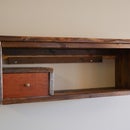Introduction: Wooden Handheld Console
Since making my retro arcade cabinet, I wanted to make a handheld version. This is what I ended up with. It's made out of cherry and the buttons/d-pad are made out of oak. The handheld features a 5" TFT screen, 1" speaker, Raspberry pi 2, HDMI decoder board, power boost 1000c board, 2.5 watt amp and a 2500mah battery. For the finish, I simply applied 3 coats of shellac straight from the can.
Be sure to check out the video above for more details and information
Products used to make this handheld:
Miter box: http://amzn.to/2nr83Hp
Saw: http://amzn.to/2ndpqK8
5/8 Dowel rods: http://amzn.to/2ndpqK8
3/8 Dowel rods: http://amzn.to/2ndpqK8
1/8 Dowel rods: http://amzn.to/2ndpqK8
Dremel Tool: http://amzn.to/2ndpqK8
Raspberry Pi: http://amzn.to/2ndpqK8
HDMI decoder board: http://amzn.to/2ndpqK8
1000C Power Board: http://amzn.to/2ndpqK8
2.5 Watt Amplifier: http://amzn.to/2ndpqK8
HDMI ribbon cable: http://amzn.to/2ndpqK8
5 inch tft screen: http://amzn.to/2ndpqK8
Speaker: http://amzn.to/2ndpqK8
Controllers: http://amzn.to/2ndpqK8
Scroll Saw: http://amzn.to/2ndpqK8
Drill Press: http://amzn.to/2ndpqK8
Forstener Bit Set: http://amzn.to/2ndpqK8
Diamond Needle Files: http://amzn.to/2ndpqK8
Step 1: Hollow Out the Inside of the Handheld Case
To begin, I trace a line around the wooden block with a combination square that will act as a ledge for the back panel to rest on. I then head over to the drill press to remove a majority of the waste using a forstner bit.
Using a chisel, I clean up the sharp corners left by the round bit and then switch over to a flush trim bit in my router to remove the rest.
Step 2: Cut the Screen Out
Using a 3/8" drill bit, I make 4 pilot holes for the jigsaw blade to fit in to cut the screen out. I then go back to the router to clean the edges up using the same flush trim bit.
Step 3: Inset the Screen
This step is optional but I used a rabbeting bit in the router table to inset the screen 1/8".
Step 4: Mark for the Buttons
To mark the buttons I used an existing controller as my template. On the right side of the screen I made a centerline that I then referenced when tracing for the buttons.
Next up I used a 1/8" drill bit and made a hole in the center of each of the buttons. This gave me a center hole for drilling the button holders on the inside of the case. To drill for the button holders I used a 5/8" forstner bit at the drill press.
Step 5: Install the Button Holders
The button holders were made out of 5/8" dowel rods that I cut using a miter box. In the previous step I used the drill press to make holes on the inside of the case for the dowel rods so in this step i'm gluing them in to place. After the glue dried I used a 3/8" forstner bit to then drill all the way through for the buttons.
Step 6: Making the Buttons
I used 3/8" dowel rods for the buttons. To keep the buttons from falling through the holes, I made a groove on the end of the button to hold a 1/8" dowel rod. Before gluing the 1/8" dowel rod in the groove, I first cut the button to length and then pillowed the ends using my hand drill and some sandpaper. I found that by putting sandpaper on top of a scotch brite pad when I sanded them, it made the ends look exactly like buttons.
With the buttons sanded, I then glued the 1/8" dowel rod in to place on the ends.
Step 7: Making the D-pad
Just like I marked on the right side of the screen for the buttons, I did the same on the left side of the screen for the D-pad. Again, just using the plastic controller as my template. On the inside of the case, I installed a 1 1/8" dowel rod to hold the d-pad in place.
To make the D-pad , I printed off a template of the d-pad I made in photoshop and used my scroll saw to cut it out. I then glued the D-pad to a 1" dowel rod.
Step 8: Cut Out the D-pad Shape on the Handheld
I used a 1/4" straight bit in my handheld router to remove a majority of the waste. This got me close, but not close enough so I used some diamond needle files to remove the rest of the waste.
Step 9: Cutting Out the Speaker Hole and Making the Grill
I cut a 1" hole below the D-pad using a forstner bit at the drill press for the speaker. To protect the speaker, I covered the hole with some speaker grill that I covered with some speaker grill cloth.
Step 10: Shaping the Case
The case needed to be shaped as it just looked like a block. I first started by installing a 1/4" thick back panel to make sure that when I started cutting away waste, the back panel fit perfectly. To start, I used a bottle of CA glue as a template for the rounded corners. I marked all 4 corners. To remove the waste I went over to the bandsaw and then over to the disk sander to clean up the rest.
Finally, to ease the edges, I used a 1/4" round over bit in the router table.
Step 11: Dowel Rods to Hold the Electronics
I installed 3/8" dowel rods on the inside of the case around the button holders to allow me to screw the electronics to.
Step 12: Cutting the Circuit Boards
The last part of this project was the electronics. I used the internals from a cheap snes controller that I got from adafruit. I placed the circuit board in the case and made a mark as to where I needed to cut them using a dremel tool. After all of the pieces were cut, I then soldered all of the contact points.
Step 13: Install Micro Usb Charging Port and Power Switch
On the back panel I traced and then cut out the holes for the micro usb cable and the power switch using the drill press and then the scroll saw. To clean the holes up I went back to the needle files.
Step 14: Sand and Finish the Case
I sanded the case with 120, 180 and 220 grit sandpaper with my sander. I then sanded the edges by hand using the same grits. For the finish, I wanted something easy to apply so I applied 3 coats of shellac just using a cotton cloth.
Step 15: Installing the Electronics
To install the circuit boards, I used the small screws that came with the plastic snes controller case. I simply screwed them in to the 3/8" dowel rods that I installed earlier. For the screen, speaker, micro usb port and the power port, I used hot glue to hold them in to place. And finally, I used brass standoffs to mount the Raspberry pi 2 and HDMI decoder board.
Resources below for the software side of things:
https://learn.adafruit.com/retro-gaming-with-raspb...
https://learn.adafruit.com/adafruit-tfp401-hdmi-sl...
https://learn.adafruit.com/super-game-pi/prep-butt...
Step 16: Final Pictures
Thanks again for checking the project out! If you want to see more of my projects, subscribe to my YouTube channel or follow my work over on my website.

Participated in the
Woodworking Contest 2017

Participated in the
Microcontroller Contest 2017













